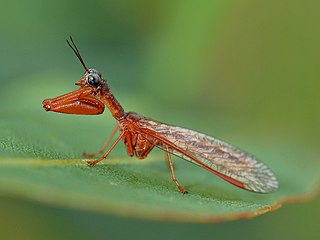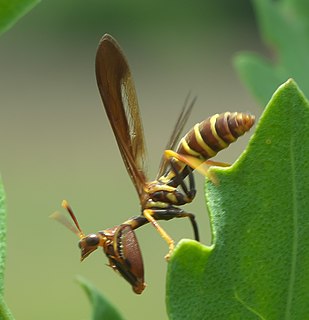
The insect order Neuroptera, or net-winged insects, includes the lacewings, mantidflies, antlions, and their relatives. The order consists of some 6,000 species. Neuroptera can be grouped together with the Megaloptera and Raphidioptera in the unranked taxon Neuropterida including: alderflies, fishflies, dobsonflies, and snakeflies.

Mantispidae, known commonly as mantidflies, mantispids, mantid lacewings, mantisflies or mantis-flies, is a family of small to moderate-sized insects in the order Neuroptera. There are many genera with around 400 species worldwide, especially in the tropics and subtropics. Only 5 species of Mantispa occur in Europe.

Leptomantispa pulchella is a species of mantidfly in the family Mantispidae. It is found in the Caribbean Sea, Central America, and North America.

Leptomantispa is a genus of mantidflies in the family Mantispidae. There are about seven described species in Leptomantispa.

Mantispinae is a subfamily of mantidflies in the family Mantispidae. There are at least 30 genera and 310 described species in Mantispinae.

Zeugomantispa minuta, the green mantisfly, is a species of mantidfly in the family Mantispidae. It is found in the Caribbean Sea, Central America, North America, and South America.

Zeugomantispa is a genus of mantidflies in the family Mantispidae. There are at least three described species in Zeugomantispa.
Xeromantispa is a genus of mantidflies in the family Mantispidae. There is one described species in Xeromantispa, X. scabrosa.

Dicromantispa interrupta is a species of mantidfly in the family Mantispidae. It is found in Central America and North America.

Dicromantispa is a genus of mantidflies in the family Mantispidae. There are about 10 described species in Dicromantispa.

Micromus variegatus is a species of brown lacewing in the family Hemerobiidae. It is found in Europe & Northern Asia and North America.
Vella fallax is a species of antlion in the family Myrmeleontidae. It is found in the Caribbean Sea, Central America, North America, and South America.
Eremochrysa canadensis is a species of green lacewing in the family Chrysopidae. It is found in North America.

Dicromantispa sayi is a species of mantidfly in the family Mantispidae. It is found in the Caribbean Sea, Central America, and North America.
Hemerobius bistrigatus is a species of brown lacewing in the family Hemerobiidae. It is found in North America.
Yumachrysa is a genus of green lacewings in the family Chrysopidae. There are at least four described species in Yumachrysa.
Nolima is a genus of mantidflies in the family Mantispidae. There are about seven described species in Nolima.
Dysmicohermes ingens is a species of fishfly in the family Corydalidae. It is found in North America.
Nallachius pulchellus is a species of pleasing lacewing in the family Dilaridae. It is found in the Caribbean Sea, Central America, and North America.

Climaciella is a genus of wasp mantidflies in the family Mantispidae. There are about 10 described species in Climaciella, found in North, Central, and South America. Climaciella brunnea, a wasp mimic, is a common species found in Central and North America.









